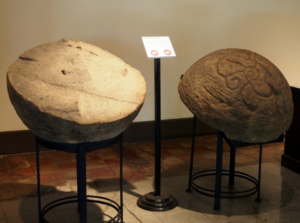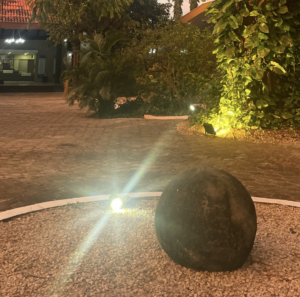
The Diquis spheres, or as they are referred to in Costa Rica “las balos”, are ancient artifacts of unknown origin despite primarily being kept in their country of origin. They were discovered in the 1930s while the Diquis Delta area was being cleared for a new banana plantation. Since then, many have been destroyed or moved to other parts of Costa Rica to use as decoration. They are undoubtedly manmade; however, they’re still a mystery as the native populations who made them were invaded by the Spanish, and the spheres’ meaning was lost to time. But they remain a point of great pride to Costa Ricans and are viewed as a part of their culture.
My interest in the Diquis spheres arises from their unique position as compared to many other artifacts with unknown histories. For example, when I bought a handmade bracelet in Costa Rica, I can turn and ask any local about its significance and they’ll be able to explain what it’s for. Its history may be unknown to me, but it is known somewhere in the world. Instead with the spheres, we see an instance of all records of the purpose of these objects being entirely lost when left behind due to invasion. Because of this, questions about whether or not they should be on display are difficult for anyone to answer since we don’t know if they are funerary objects or of major religious meaning.

Questions like this have to be answered though, when places like the MET have them on display. As a result, many different origins are proposed for the spheres, some already disproven, like the theory that they contained gold or precious stones. Others speculate that they were meant to track stars or signify rank. The ethics of finding out with certainty can be murky though, as justifying damage to the spheres is difficult if there’s no evidence it would be beneficial. Even the fact that they have been moved has become an issue, as now we have no location for a lot of these artifacts to base our theories around. My personal guess is that they were just meant to be art, since from what we do know about the civilization that created them, they were well functioning and would have the resources to dedicate time to art, rather than just survival. But even then, it’s hard to know if the original creators would want their art on display in other countries’ museums.

In some cases, these spheres aren’t even on display indoors but are outside in Costa Rica as decoration. While staying at a Marriott in Costa Rica, I saw a small stone sphere in the courtyard and couldn’t help but wonder if it was authentic or not. Most visitors may not even realize there’s a possibility that it’s of any importance or the huge debate around them.
Regardless of their original meaning, I think the spheres have been repurposed after their rediscovery, and in a way transformed into new objects. Until something is defined by people, it ceases to have an identity as a specific thing. We may not know what they used to be but we know how the people of Costa Rica feel about them now. Even with no understanding of their history, they can be identified with certainty as part of culture today.
Sources:
https://www.metmuseum.org/art/collection/search/321295
https://earthlymission.com/diquis-ancient-stone-spheres-costa-rica-archaeology-mystery/
http://www.ancient-wisdom.com/costarica.htm
https://www.museocostarica.go.cr/
Banyasz, Malin Grunberg. “OFF THE GRID.” Archaeology, vol. 67, no. 6, 2014, p. 10–.